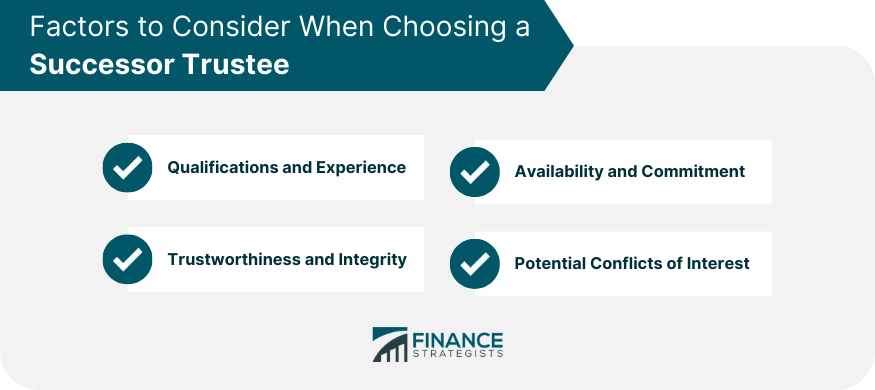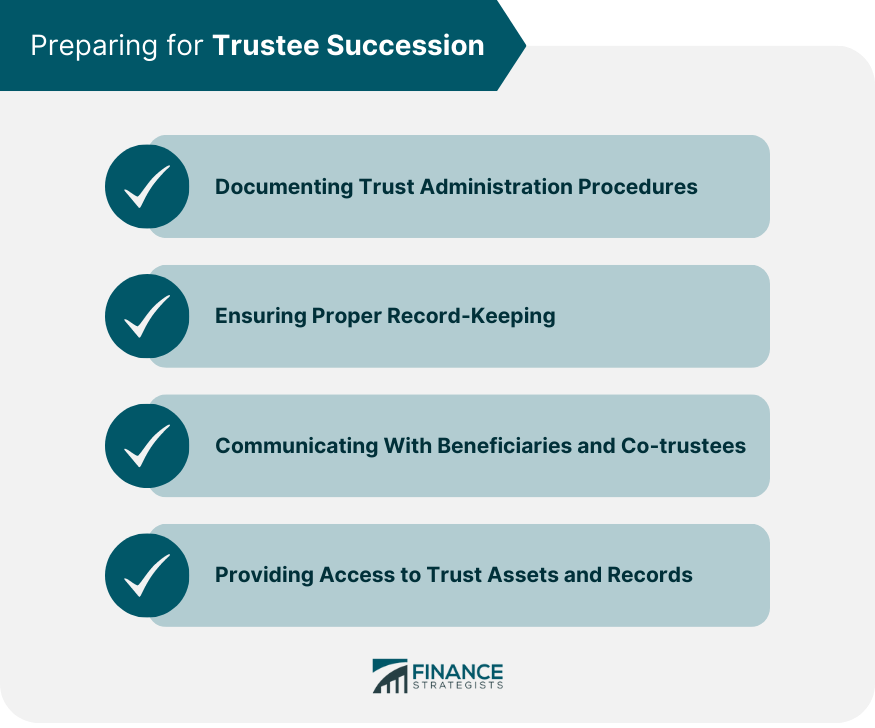Trustee succession refers to the process of replacing an existing trustee with a new trustee, ensuring the ongoing administration and management of the trust. This can occur when a trustee resigns, becomes incapacitated, or passes away. Planning for trustee succession is crucial to ensure the continued administration of the trust, protect trust assets, and fulfill the trust's purposes for the benefit of its beneficiaries. The trust agreement typically outlines the procedures for trustee succession, including the methods of appointing a successor trustee and any qualifications or criteria that the successor trustee must meet. State laws may also govern trustee succession and provide additional requirements or procedures that must be followed. Trustee succession laws can vary from state to state, making it essential for trustees to be familiar with the applicable regulations. In some cases, the settlor (the person who created the trust) may have designated a successor trustee in the trust agreement. This is a common method of trustee succession planning, providing clarity and certainty regarding the trust's future administration. If the trust agreement allows, co-trustees or beneficiaries may have the authority to appoint a successor trustee. This method can give the trust's stakeholders greater control over the selection of the new trustee, ensuring that their interests are protected. A trust protector is an individual or entity appointed by the settlor to oversee the trust and make specific decisions, such as appointing or removing trustees. If the trust agreement grants this authority, a trust protector can appoint a successor trustee. If the trust agreement does not provide a method for appointing a successor trustee or if the designated method fails, a court may have the authority to appoint a new trustee. This typically occurs when there is a dispute among beneficiaries or when other appointment methods are unsuccessful. A suitable successor trustee should have the necessary qualifications and experience to administer the trust effectively. This may include knowledge of trust law, financial management skills, and experience in dealing with trust assets and beneficiaries. The successor trustee should be a person of high integrity and trustworthiness, as they will be responsible for managing the trust's assets on behalf of the beneficiaries and ensuring the trust's continued success. A successor trustee should be willing and able to commit the time and effort required to administer the trust effectively. This may involve regular communication with beneficiaries, managing trust assets, and fulfilling legal and reporting obligations. It is essential to consider any potential conflicts of interest that could arise between the successor trustee and the trust's beneficiaries or assets. A trustee with a conflict of interest may not be able to act impartially or fulfill their fiduciary duties effectively. To ensure a smooth transition to a successor trustee, the current trustee should document the trust's administration procedures, including asset management strategies, distribution policies, and reporting requirements. Accurate and up-to-date records of trust administration are crucial for a smooth trustee succession. These records should include financial statements, tax filings, beneficiary information, and correspondence related to the trust. Open communication with beneficiaries and co-trustees is essential during the trustee succession process. Keeping all parties informed about the succession plan can help maintain trust and facilitate a smooth transition. The current trustee should ensure that the successor trustee has access to the trust's assets and records, making it easier for the new trustee to take over the trust administration. When a trustee succession occurs, it is important to notify all relevant parties, including beneficiaries, co-trustees, and any professional advisors involved with the trust. The outgoing trustee must transfer all trust assets, records, and relevant documentation to the successor trustee to ensure a seamless transition. The outgoing trustee may provide assistance to the successor trustee during the transition, such as explaining the trust's administration, providing guidance on trust assets, and offering support in understanding the trust agreement. The outgoing trustee should obtain a release of liability from the beneficiaries and co-trustees to protect themselves from future claims related to their tenure as trustee. This release may be in the form of a written agreement or a court order. It is essential to review the trust's succession plan periodically to ensure that it remains up-to-date and reflects the trust's current circumstances and objectives. Maintaining regular communication with the designated successor trustee can help ensure that they are prepared to take over the trust administration when needed and are familiar with the trust's objectives, assets, and beneficiaries. Keeping the trust agreement and other trust documents up-to-date can help ensure that the trustee succession process is clear, efficient, and in line with the trust's objectives. Trustee succession planning is crucial for the continued administration and success of a trust. Various methods can be used to appoint a successor trustee, and numerous factors should be considered when choosing a suitable candidate. Proper preparation, communication, and record-keeping can help facilitate a smooth transition to a successor trustee. Effective trustee succession planning ensures that the trust can continue to fulfill its purposes and protect the interests of its beneficiaries, even when the current trustee is no longer able to serve. By following best practices for trustee succession planning and working closely with the successor trustee, the current trustee can help safeguard the trust's assets and promote the continued administration and success of the trust for the benefit of its beneficiaries.What Is Trustee Succession?
Legal Framework Governing Trustee Succession
Trust Agreement Provisions
State Laws and Regulations
Methods of Trustee Succession
Appointment by the Settlor
Appointment by Co-trustees or Beneficiaries
Appointment by a Trust Protector
Appointment by a Court
Factors to Consider When Choosing a Successor Trustee
Qualifications and Experience
Trustworthiness and Integrity
Availability and Commitment
Potential Conflicts of Interest

Preparing for Trustee Succession
Documenting Trust Administration Procedures
Ensuring Proper Record-Keeping
Communicating With Beneficiaries and Co-trustees
Providing Access to Trust Assets and Records

Transitioning to a Successor Trustee
Notifying Relevant Parties
Transferring Trust Assets and Records
Assisting With the Transition Process
Obtaining a Release of Liability
Best Practices for Trustee Succession
Periodic Review of Succession Plan
Regular Communication With Successor Trustee
Maintaining Updated Trust Documents
Conclusion
Trustee Succession FAQs
Trustee Succession is the process of appointing a new trustee to manage a trust when the current trustee is no longer able or willing to fulfill their duties. This may occur due to retirement, illness, death, or other reasons.
The steps involved in Trustee Succession typically include reviewing the trust document to determine the procedures for appointing a new trustee, identifying potential candidates, and obtaining their consent to serve as trustee. The outgoing trustee may need to provide a resignation letter or other documentation, and the new trustee will need to accept their appointment in writing. Finally, the trust assets will need to be transferred to the new trustee, who will assume responsibility for managing the trust.
Any individual or organization that is legally capable of managing a trust can be appointed as a new trustee. This may include a family member, friend, financial advisor, attorney, or trust company. The specific qualifications for a new trustee may depend on the terms of the trust and the complexity of its assets.
If the trust document does not provide procedures for Trustee Succession, the appointment of a new trustee may need to be determined by a court or other legal authority. In this case, interested parties may petition the court to appoint a new trustee or to approve the appointment of a nominated trustee. The court will consider the best interests of the trust and its beneficiaries when making its decision.
When choosing a new trustee, it is important to consider their qualifications, experience, and trustworthiness. The new trustee should have the necessary knowledge and skills to manage the trust's assets effectively and make decisions that are in the best interests of the beneficiaries. They should also have a good reputation and a record of acting with integrity and transparency. Other factors to consider may include the trustee's availability, fees, and willingness to work with the trust's advisors and beneficiaries.
True Tamplin is a published author, public speaker, CEO of UpDigital, and founder of Finance Strategists.
True is a Certified Educator in Personal Finance (CEPF®), author of The Handy Financial Ratios Guide, a member of the Society for Advancing Business Editing and Writing, contributes to his financial education site, Finance Strategists, and has spoken to various financial communities such as the CFA Institute, as well as university students like his Alma mater, Biola University, where he received a bachelor of science in business and data analytics.
To learn more about True, visit his personal website or view his author profiles on Amazon, Nasdaq and Forbes.











